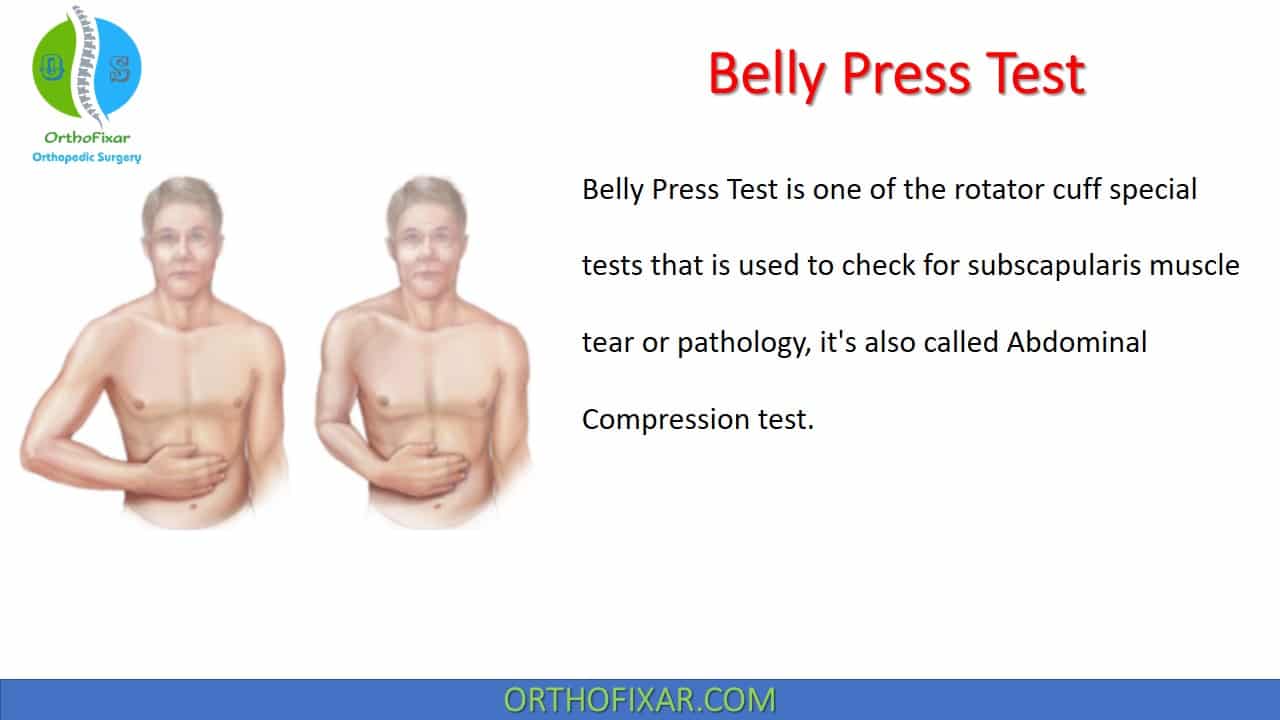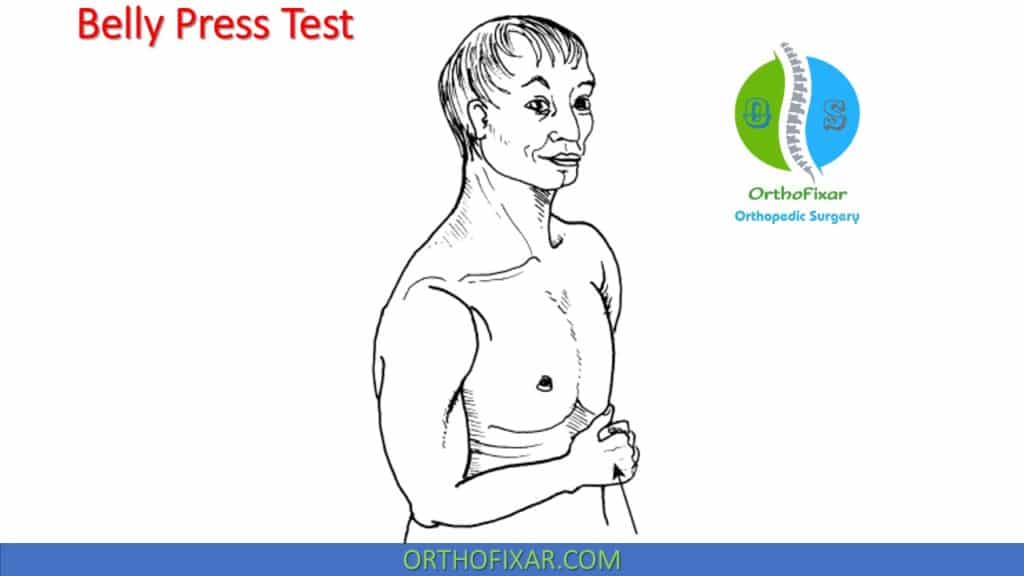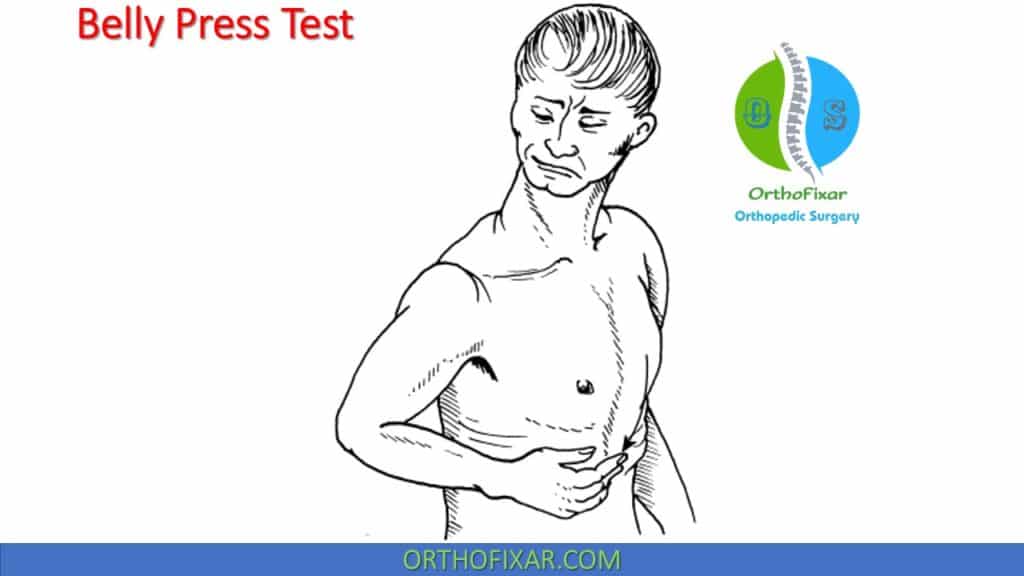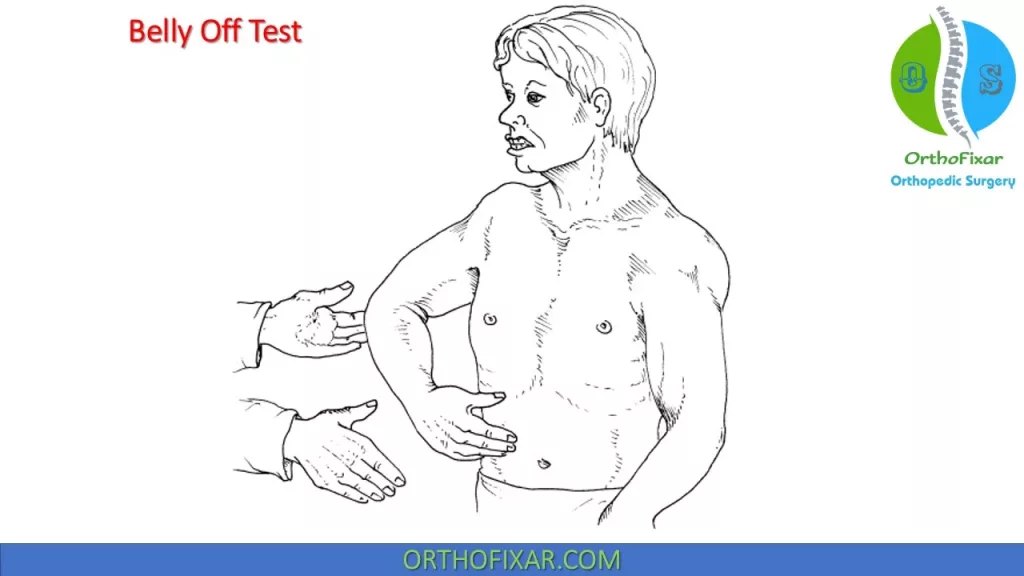Belly Press Test

Belly Press Test is used to check for subscapularis muscle tear or pathology, it’s also called Abdominal Compression test or sometimes a Napoleon test.
How do you do the Belly Press Test?
- The patient is standing.
- The examiners places the patient’s forearm on the abdomen with the elbow flexed and the arm maximally internally rotated.
- The examiner’s hand is placed between the patient’s hand and abdomen so that the strength of the subsequent pressure can be felt.
- The patient is now requested to press the arm forcefully against the abdomen while holding the elbow forward.
See Also: Rotator cuff of the shoulder


What does a positive Belly Press Test mean?
Belly Press Test is positive if the strength of the subscapularis is impaired, maximal internal rotation cannot be maintained, the patient feels weakness, and the elbow deviates laterally and posteriorly under the influence of the latissimus dorsi and teres major muscles, he also tends to flex the wrist to press against the abdomen.
See Also: Drop Arm Test

Sensitivity & Specificity
A study by Márcio Schiefer for clinical diagnosis of subscapularis tendon tears, he found that the Belly press test gave the greatest specificity but low Sensitivity:
- Sensitivity: 40 %
- Specificity: 97.9 %
Another study founds that the active compression test (acromioclavicular joint), belly press tests (observation and weakness), Kim test and drop-arm test demonstrate acceptable levels of interexaminer reliability in a group of patients with sub-acute and chronic shoulder conditions.
A study on 312 patients scheduled to undergo arthroscopic shoulder surgery (Subscapularis tear diagnosed via arthroscopic visualization) the sensitivity and specificity of belly press test was 28% and 99%, respectively.
Modified belly press test
With the hand flat on the abdomen and the elbow close to the body, the patient is asked to bring the elbow forward and straighten the wrist. The final wrist flexion position or belly-press angle of the wrist is then measured by a goniometer.
The test is considered positive if the measured bellypress angle at the wrist shows a side-to-side difference of at least 10 degrees.
A study on 55 patients suffering from subacromial and/or glenohumeral impingement syndrome scheduled for an arthroscopic procedure (Subscapularis tear diagnosed via arthroscopic visualization), the sensitivity and specificity of Modified belly press test was 80% and 88%, respectively.
Belly Off Test
It’s a new clinical sign for subscapularis muscle lesions.
The arm of the patient is passively brought into flexion and maximum internal rotation with the elbow flexed at 90 degrees. The elbow is supported by one hand of the examiner while the examiner’s other hand brings the arm into maximum internal rotation, placing the palm of the patient’s hand on the abdomen. The patient is asked to keep the wrist straight and actively maintain the position of internal rotation as the examiner releases the wrist.
Test is positive if the patient cannot maintain that position, if the wrist is flexed or lag occurs, and if the hand is lifted off the abdomen. In the case of an isolated partial subscapularis tendon tear, this test is usually positive as a result of the preponderance of externally rotating forces.
A study on 55 patients suffering from subacromial and/or glenohumeral impingement syndrome scheduled for an arthroscopic procedure (Subscapularis tear diagnosed via arthroscopic visualization), the sensitivity and specificity of Belly Off Test was 86% and 91%, respectively.


References
- Márcio Schiefer,Yonder Archanjo Ching-San Júnior, Sérgio Maurício Silva, César Fontenelle, Marcos Genúncio Dias Carvalho, Fabio Garcia de Faria, and José Sérgio Franco: CLINICAL DIAGNOSIS OF SUBSCAPULARIS TENDON TEAR USING THE BEAR HUG SEMIOLOGICAL MANEUVER. Rev Bras Ortop. 2012 Sep-Oct; 47(5): 588–592. PMID: 27047870.
- Gerber C, Krushell RJ: Isolated rupture of the tendon of the subscapularis muscle: clinical features in 16 cases. J Bone Joint Surg 73B:389–394, 1991.
- Scheibel M, Magosch P, Pritsch M, Lichtenberg S, Habermeyer P. The belly-off sign: a new clinical diagnostic sign for subscapularis lesions. Arthroscopy. 2005 Oct;21(10):1229-35. doi: 10.1016/j.arthro.2005.06.021. PMID: 16226652.
- Cadogan A, Laslett M, Hing W, McNair P, Williams M. Interexaminer reliability of orthopaedic special tests used in the assessment of shoulder pain. Man Ther. 2011 Apr;16(2):131-5. doi: 10.1016/j.math.2010.07.009. PMID: 20810303.
- Bartsch M, Greiner S, Haas NP, Scheibel M. Diagnostic values of clinical tests for subscapularis lesions. Knee Surg Sports Traumatol Arthrosc. 2010;18(12): 1712-1717.
- Yoon JP, Chung SW, Kim SH, Oh JH. Diagnostic value of four clinical tests for the evaluation of subscapularis integrity. J Shoulder Elbow Surg. 2013; 22(9):1186-1192.
- Clinical Tests for the Musculoskeletal System 3rd Edition.
- Dutton’s Orthopaedic Examination, Evaluation, And Intervention 3rd Edition.
- Lifetime product updates
- Install on one device
- Lifetime product support
- Lifetime product updates
- Install on one device
- Lifetime product support
- Lifetime product updates
- Install on one device
- Lifetime product support
- Lifetime product updates
- Install on one device
- Lifetime product support